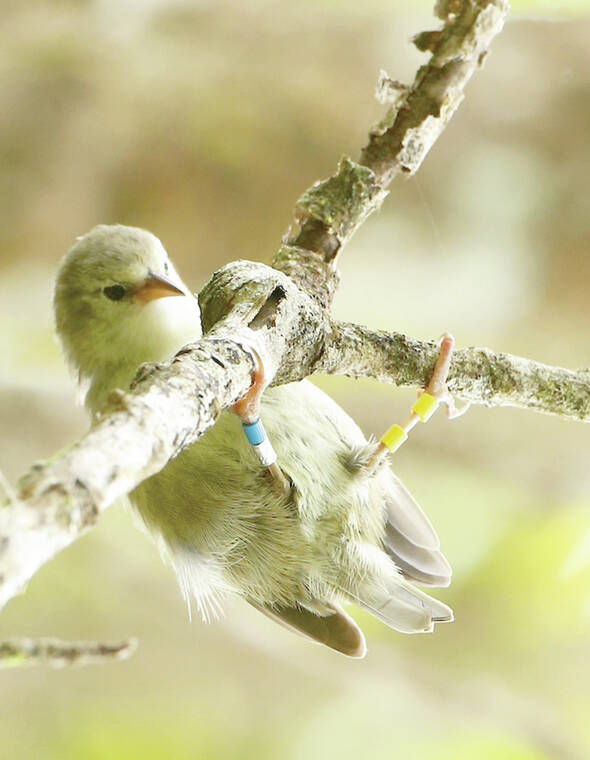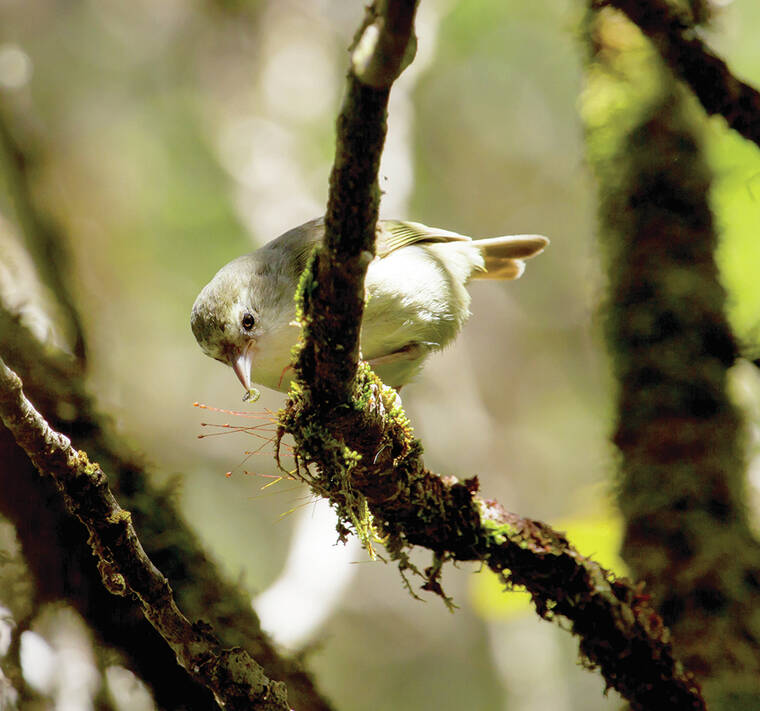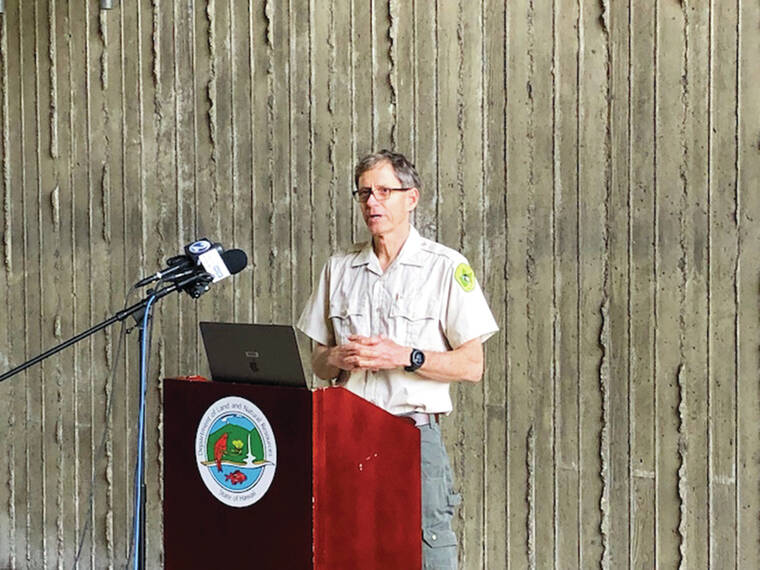LIHU‘E — Two Kaua‘i forest birds may go extinct in the next four years, even as state and federal agencies, backed by a new report, work to save them.
An estimated 45 ‘akikiki (Oreomystis bairdi) and 638 ‘akeke‘e (Loxops caeruleirostris) remain in the wild on Kaua‘i, where they are endemic.
But these species are not the only Hawaiian honeycreepers in crisis. The kiwikiu (Pseudonestor xanthophrys) and the ‘akohekohe (Palmeria dolei), both found only on Maui, may die out as well.
“We’re looking at an immediate danger of Hawaiian species going extinct, so we’re gonna race to try to save them,” said David Smith, administrator of the state Department of Land and Natural Resources Division of Forestry and Wildlife, at a press conference held Thursday in Honolulu.
The main culprit is avian malaria transmitted by invasive house mosquitoes (Culex quinquefasciatus), according to Smith, who was joined by speakers from the U.S. Geological Survey, the U.S. Department of the Interior and the U.S. Fish and Wildlife Service.
The disease, often fatal to Hawaiian honeycreepers, is exacerbated by climate change. Warming temperatures have allowed mosquitoes to enter the birds’ high-elevation habitat, thereby increasing disease distribution.
Agencies are working on a landscape-scale mosquito-control program, using the Wolbachia incompatible insect technique.
It’s one of three conservation actions evaluated in a 125-page report published by the Hawai‘i Cooperative Studies Unit at the University of Hawai‘i at Hilo on April 14.
Wolbachia IIT sees lab-reared, male mosquitoes injected with a strain of Wolbachia, a bacteria that inhabits many insects.
When two mosquitoes with different types of Wolbachia mate, their eggs can be infertile, according to the report.
A large-scale, continuous release of male mosquitoes in Hawai‘i could therefore suppress existing mosquito populations and buy time for the islands’ critically endangered honeycreepers. (Male mosquitoes do not bite humans or animals.)
“It’s a highly technical and complex undertaking, and we’re hoping to get it on the ground in the next two years, possibly,” Smith said. “But that may be too late for a couple of species, so we’re looking at other conservation tools.”
These actions include captive care, which removes birds from the wild, and conservation translocation, which moves birds from one location to another, disease-free site. Both are reviewed in the new report.
A captive-care initiative is already underway on Kaua‘i. A team of six biologists captured a 6-month-old ‘akikiki chick in the Alaka‘i Wilderness Preserve in December.
The chick was flown to a Maui facility, where it joined 41 other ‘akikiki in captivity. Its stay is intended to be temporary, until biologists restore its Kaua‘i habitat, DLNR reported at the time.
Another three ‘akikiki marked for captive care remain in the wild.
“We are actively looking for opportunities to collect the rest of that family group this spring,” Dr. Lisa “Cali” Crampton, project leader of the Kaua‘i Forest Bird Recovery Project, told The Garden Island on Friday.
Crampton’s work is cited in the April 14 report, “Hawaiian Forest Bird Conservation Strategies for Minimizing the Risk of Extinction: Biological and Biocultural Considerations.”
The report does not recommend a specific course of action. It evaluates which actions might prevent extinction and what decision makers should consider when they implement any of the evaluated actions, a DLNR press release states.
“This collective effort shows that everyone is behind the birds,” Crampton said. “The whole state, the whole federal government, everyone is standing ready. It’s really gratifying to know that we’ve got everyone on board.”
Native Hawaiian perspectives
Thirteen Native Hawaiians met with personnel from several federal agencies throughout autumn 2021.
The two groups discussed the history and cultural importance of Hawaiian forest birds, and the ramifications of proposed conservation plans. Key takeaways were documented in the new report’s 28-page biocultural assessment.
“Across that spectrum of input, we really tried to capture the large array of voices and ideas and thoughts, and be able to present them in a manner that was comprehensive for decision makers,” report co-author Stanton Enomoto, of the U.S. Department of the Interior’s Office of Native Hawaiian Relations, said on Thursday.
The report seeks to emphasize Native Hawaiian voices in any kind of management action plan going forward, Enomoto said.
The wide-ranging assessment touches on many topics, including bird translocations performed by Queen Lili‘uokalani in the late 1800s, the relationship between U.S. government agencies and the Native Hawaiian community, and the appropriateness of certain conservation methods.
The assessment reports participants shared concerns regarding captive-care programs outside of Hawai‘i.
“Like we have a family member in a hospital here in Hawai‘i, it was expressed as equally important that these birds be kept as close to Hawai‘i or in their native habitat as possible, to ensure or enhance their best chance of recovery,” Enomoto said Thursday. “And in the unfortunate event they decline, family is there to look after them, to take care of them and sustain those important relationships going forward.”
•••
Scott Yunker, reporter, can be reached at 245-0437 or syunker@thegardenisland.com.






